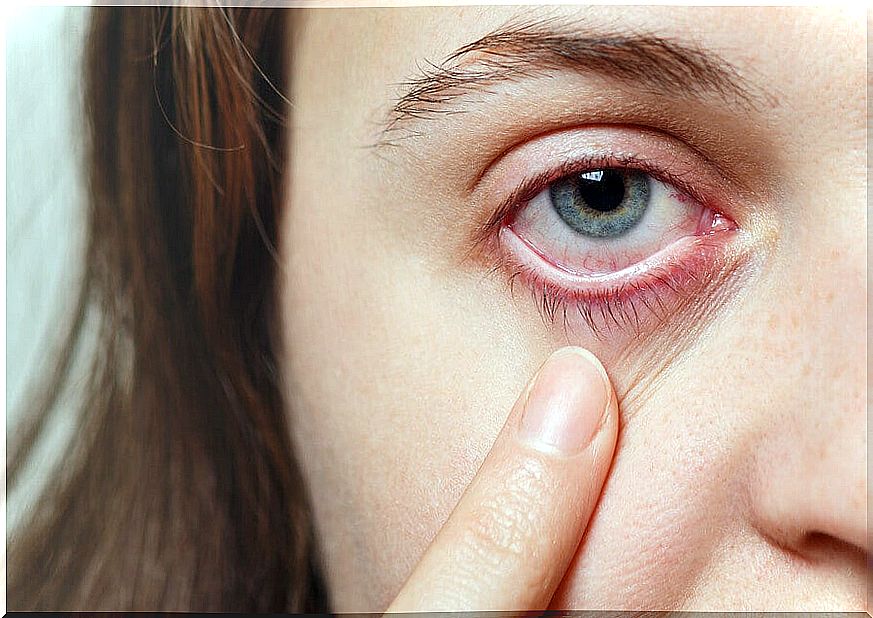Ocular Migraines: How Can They Affect You?
Ocular migraines are a clinical type of migraine. They usually last for a short period of time and may or may not be accompanied by a headache. In this article we tell you how you can recognize them and what you can do both to treat and prevent them. Find out!
What are ocular migraines?
Ocular migraines, also called ophthalmic migraines, refer to a condition that manifests itself with a temporary and painless visual disorder, which can occur in only one or both eyes. Migraine is a strong and sharp headache that is caused by a sudden alteration of the cerebral blood flow.
Since this alteration affects the entire brain, different functions can be affected, including vision. This disorder often resolves on its own in less than an hour, and although its symptoms may seem alarming, it is almost always a benign process.

What Causes Eye Migraines?
Ocular migraines can affect anyone. It seems that they have a genetic basis. That is, a part of this pathology is inherited in a family way.
On the other hand, there are various factors that, as we have said, can alter the cerebral blood flow causing this ailment. Some of them can be:
- Stress
- Lack of sleep
- Certain light stimuli
- Intake of certain foods or beverages such as chocolate, coffee, alcohol, aged cheese, etc.
Also, on some occasions, this type of migraine has been linked to diseases such as epilepsy, lupus or certain types of anemia.
What symptoms do ocular migraines produce?
Ocular migraines can affect one or both eyes. As Dr. Jerry Swanson, a board-certified neurologist at the Mayo Clinic, explains, visual symptoms don’t last long.
However, these can temporarily interfere with activities such as reading or driving. In addition, the following clinical manifestations are described:
- Blind spots may appear, especially in the central part of the visual field. These points are called scotomas. Its size can vary and even affect the entire vision. They can appear in one or both eyes.
- Vision of flashing spots or lights.
- The patient may have double vision.
- Increased sensitivity to light or some sounds.
These visual symptoms may be accompanied by nausea, vomiting, or a headache. This headache characteristically affects only one side, putting more pressure on the eyes. It worsens with exertion and improves with rest in quiet, dark places.

Treatment and prevention
People who have ocular migraines will probably have them throughout their lives. There will be times when, due to different factors, they present more or more intensity ; in the same way, they will have times when they are less.
Therefore, it is important that each person learn to recognize their symptoms, their frequency and the measures they can take to control the crisis. In most cases, eye migraines resolve on their own in about an hour.
When an ocular migraine attack with visual symptoms appears suddenly, and the person is carrying out tasks that can be dangerous, it is important to stop and rest until the symptoms disappear and it is safe.
It will always be advisable, before the first episodes, to go to the doctor so that a complete examination is carried out and some of the diseases that can cause this type of migraine are ruled out.
From here, the doctor will decide if it is necessary to propose a treatment. This will depend on the intensity and frequency of the migraines. Treatment can be based on anti-inflammatories or analgesics such as ibuprofen and paracetamol at the time of attacks.
There are also preventive medical treatments that may be used. Even so, the most advisable thing is that each person study their case, know what factors are those that usually trigger crises and avoid them, as in the case of certain foods or activities. A good rest and stress management will always help crises are more under control.
In summary
Ocular migraines can affect anyone. Before the beginning of repeated attacks of ocular migraines, it is always advisable to go to the doctor to examine that everything is fine.
For its control and prevention, each person who suffers them must know how to recognize both the symptoms and the triggers and, in this way, avoid what may be causing it.









